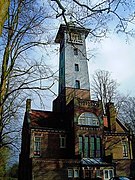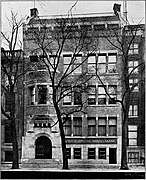Jan Frederik Staal
Jan Frederik ("Frits") Staal (born February 28, 1879 in Amsterdam , † March 8, 1940 in Amsterdam) was a Dutch architect and an important figure in the development of modern architecture in the Netherlands in the first half of the twentieth century. He was the father of the architects Arthur and Georges Staal and the linguist and South Asian researcher Jan Frederik Staal (also known as "Frits").
Professional career
Jan Frederik Staal was born into an Amsterdam building contractor family. His father was a partner in the construction company Staal und Haalmeyer, in whose office JF Staal began to work at the turn of the century. There he met Alexander Jacobus Kropholler in 1902 , with whom he founded a partnership in 1903. The partners' designs were initially built by his father's company. One of the first was the offices of the life insurance company De Utrecht am Damrak in the center of Amsterdam, which are still used by the company today and are a striking example of the Dutch Nieuwe Kunst ( Art Nouveau ) architecture in the city. At the same time, another branch of the company was completed in Leeuwarden .
In 1910, Staal and Kropholler dissolved their partnership, among other things because Kropholler's sister, Margaret Kropholler , began a love affair with Staal. whereupon Staal approached the design currents of the Amsterdam School , which merged in the Netherlands while the country remained neutral during the First World War. His first projects in this direction were the villas in Park Meerwijk in Bergen (1917-18); the central flower markets in Aalsmeer ; the Dutch pavilion at the International Exhibition of Modern Decorative and Industrial Art in Paris in 1925 (the 1925 exhibition that coined the name "Art Déco"); a twelve-story "skyscraper" in Amsterdam known as De Wolkenkrabber (1932); the new headquarters of the newspaper De Telegraaf on the Nieuwezijds Voorburgwal in Amsterdam (with GJ Langhout); the Koopmansbeurs in Rotterdam ; and various houses in the Amsterdam Rivierenbuurt (river district). In 1920 he also entered the competition for an opera house on Museumplein in Amsterdam, which he won, but his plan for the opera house was never carried out. He was later to use the motifs from this project again at the flower market in Aalsmeer and the Telegraaf building.
Towards the end of his career, Staal finally developed into a student of New Objectivity , a development that can be seen in his apartment blocks in the Apollolaan, Beethovenstraat, Corellistraat and Bachstraat in Amsterdam. His buildings on Apollolaan / Beethovenstraat are particularly characteristic of his move towards New Objectivity with their large, narrow oriels, as are the single-family houses he designed on the even-numbered side of Corellistraat. They stand in clear contrast to the earlier residential buildings that he built on JM Coenenstraat.
reception
Staal became an important figure in the history of modern Dutch architecture. For a number of years he was a board member of the Dutch architecture company Architecture et Amicitia , which met from 1914 in a bank building designed by Staal on the Herengracht in Amsterdam. From 1920 to 1930 he was also a member of the editorial team of the Dutch design magazine Wendingen . It was through these contacts that his career flourished, including the great personalities of the Amsterdam School such as Hendrik T. Wijdeveld , Michel de Klerk and Piet Kramer .
The first monograph on Staal, Jan Frederik Staal (1879–1940) - The Will of the Building and the Will of Time, was published in 2015, written by Hans Willem Bakx and published by the Bonas Foundation.
Personal
Staal was a socialist for a part of his life and even joined the Communist Party in the Netherlands.
From 1936 until his death he was married to the architect and designer Margaret Staal-Kropholler (1891–1966), with whom he had a much longer relationship and who was initially his assistant. She was the sister of Staal's former partner, Alexander Kropholler. She is buried in the New East Cemetery in Amsterdam.
Staal had five children, four of them from relationships he had with his wife before he married. His son Arthur Staal (1907–1993) was also an architect and designed the Overhoeks Tower in Amsterdam-Noord in 1966. His son Georges Staal was also an architect and a third son, Fred Staal, who died in the Dutch East Indies . A fourth son was the linguist Frits Staal (1930–2012), who, however, had a different mother than Arthur, Georges and Fred. Margareth, or Maggie Venekamp-Staal, was his youngest child from his marriage to Margaret.
Works (selection)
- 1903: Branch of Utrecht Insurance, Leeuwarden (with A. Kropholler)
- 1905: Headquarters of the Utrecht Insurance, Amsterdam, Damrak 28–30 (with A. Kropholler)
- 1905: Warehouse of Utrecht Insurance, Amsterdam, Damrak 26 (with A. Kropholler)
- 1905: Fire watchtower with the Utrecht Insurance House, Hilvarenbeek (with A. Kropholler)
- 1906: Utrecht archive building, Utrecht (with A. Kropholler; demolished)
- 1906: The Utrecht branch, Choorstraat 14, Utrecht (with A. Kropholler)
- 1913: Amsterdamsche Handelsbank, Herengracht, Amsterdam
- 1915–1918: Park Meerwijk with the villas De Ark, De Bark, Bilbad, Elifaz and Zofar, Bergen, (Noord-Holland)
- 1919–1920: Eigen Huis residential complex, Linnaeusparkweg, Amsterdam
- 1922–1923: JM Coenenstraat residential complex, Amsterdam
- 1925: Dutch pavilion for the Exposition des arts décoratifs et industriels, Paris (demolished)
- 1927–1928: Aalsmeer auction house, Aalsmeer
- 1927–1930: De Telegraaf headquarters, Nieuwezijds Voorburgwal, Amsterdam
- 1927–1930: twelve-story high-rise (“De Wolkenkrabber”), Amsterdam
- 1935: Extension, a Jewish home for the elderly and the disabled, Weesperplein, Amsterdam
- 1935–1940: Handels Beurs, Rotterdam
- 1938–1939: Apartment on the corner of Apollolaan (65–85) and Beethovenstraat (3–9), Amsterdam.
gallery
Web links
- Jan Frederik Staal - Wendingen ~ Platform voor de Amsterdamse School. In: amsterdamse-school.nl. Retrieved January 7, 2020 (Dutch).
- Jan Frederik Staal. In: arch INFORM .
Individual evidence
- ^ Kropholler, Margaret (1891-1966). In: resources.huygens.knaw.nl. October 19, 2017, accessed January 2, 2020 (Dutch).
- ↑ Staal, Jan Frederik. In: zoeken.hetnieuweinstituut.nl. Retrieved January 7, 2020 (Dutch).
- ↑ Torenlaan 1 5085 NL te Esbeek. In: monumentenregister.cultureelerfgoed.nl. October 15, 2019, accessed January 7, 2020 (Dutch).
- ↑ De Utrecht Choorstraat 14 3511 KM te Utrecht. In: monumentenregister.cultureelerfgoed.nl. October 15, 2019, accessed January 7, 2020 (Dutch).
- ↑ Herengracht 545 1017 BW te Amsterdam. In: monumentenregister.cultureelerfgoed.nl. October 15, 2019, accessed January 7, 2020 (Dutch).
- ↑ Lijtweg 13 1861 VA te Bergen (NH). In: monumentenregister.cultureelerfgoed.nl. October 15, 2019, accessed January 7, 2020 (Dutch).
- ↑ Bark Studler van Surcklaan 15 1861 MA te Bergen (NH). In: monumentenregister.cultureelerfgoed.nl. October 15, 2019, accessed January 7, 2020 (Dutch).
- ^ Nieuwezijds Voorburgwal 225 1012 RL te Amsterdam. In: monumentenregister.cultureelerfgoed.nl. October 15, 2019, accessed January 7, 2020 (Dutch).
- ↑ de Wolkenkrabber Victorieplein 45I 1078 PD te Amsterdam. In: monumentenregister.cultureelerfgoed.nl. October 15, 2019, accessed January 7, 2020 (Dutch).
- ↑ Joodsche Invalide Weesperplein 3 1018 WZ te Amsterdam. In: monumentenregister.cultureelerfgoed.nl. October 15, 2019, accessed January 8, 2020 (Dutch).
- ^ Handels Beurs Coolsingel 46A 3011 AD te Rotterdam. In: monumentenregister.cultureelerfgoed.nl. October 15, 2019, accessed January 7, 2020 (Dutch).
| personal data | |
|---|---|
| SURNAME | Staal, Jan Frederik |
| ALTERNATIVE NAMES | Staal, Frits |
| BRIEF DESCRIPTION | Dutch architect |
| DATE OF BIRTH | February 28, 1879 |
| PLACE OF BIRTH | Amsterdam |
| DATE OF DEATH | March 8, 1940 |
| Place of death | Amsterdam |










